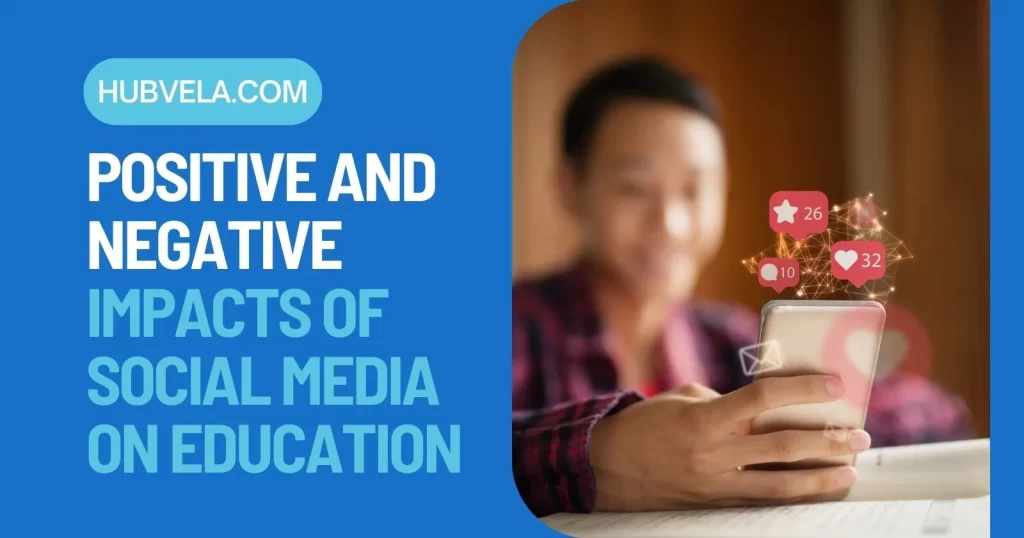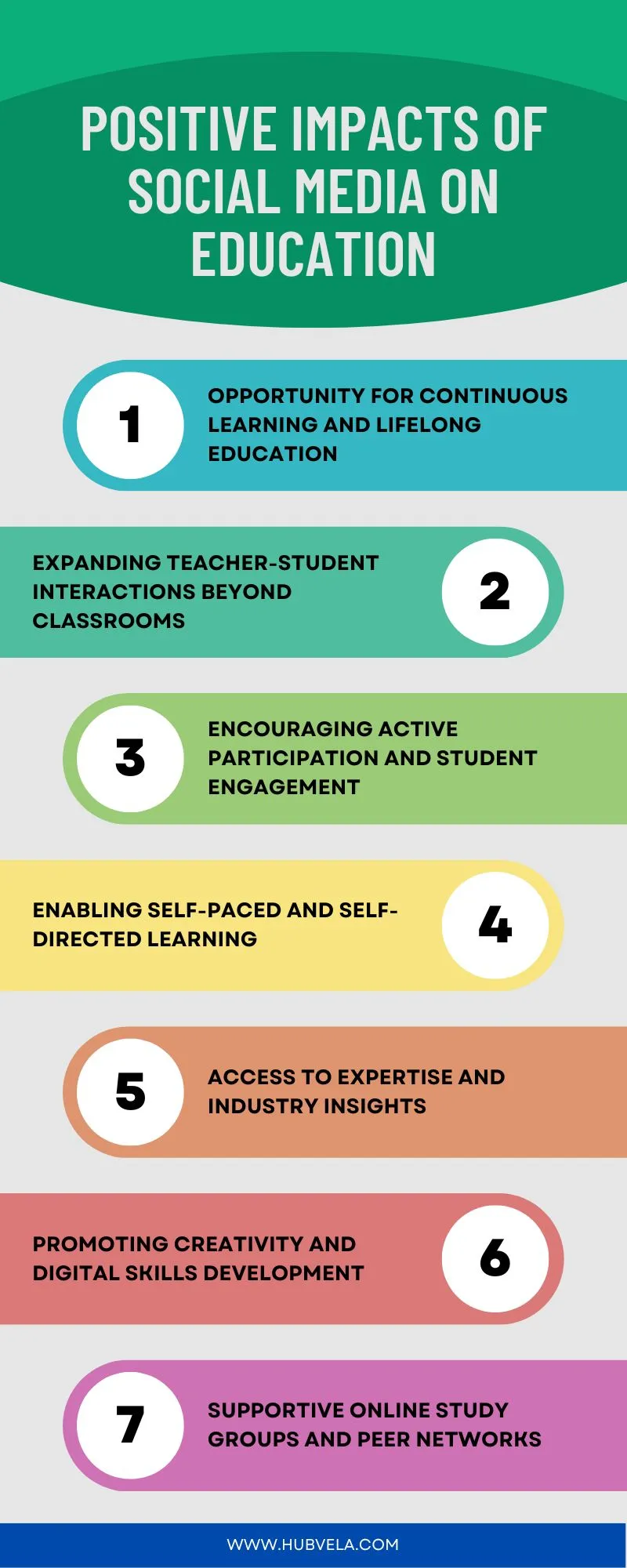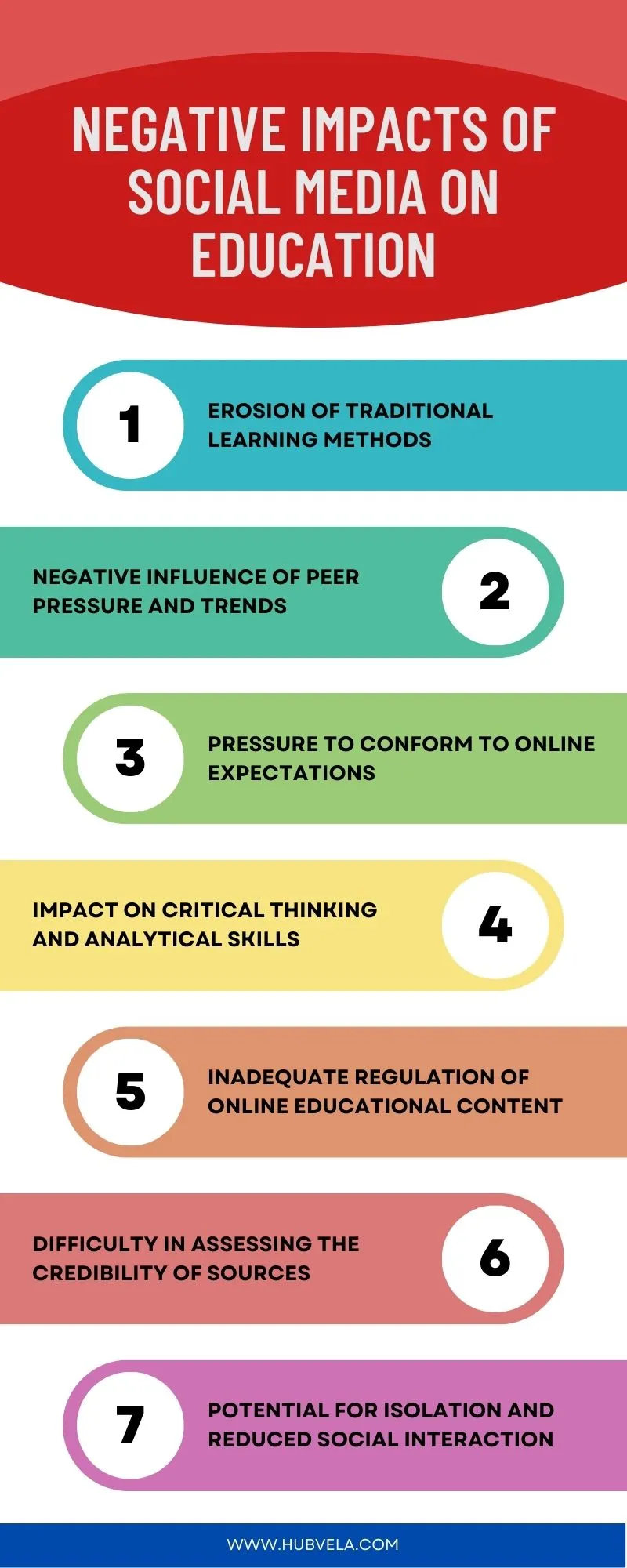Social media has become an integral part of our lives, and its impact on education is becoming increasingly significant. The world is becoming smaller, and technology such as social media is changing the way we learn.
Social media and education can complement each other if used effectively. Students are discovering new learning opportunities through social media, and it has many positive effects on education.
However, it also has some negative consequences that cannot be ignored. In this article, we will explore the positive and negative impacts of social media on education.

--Advertisement--
Positive Effects of Social Media on Education
Social media has become an integral part of our daily lives, with billions of people using various platforms to connect with others, share information, and consume content.
In recent years, researchers have explored the role of social media in improving academic performance and enhancing the learning experience. This article will examine the positive effects of social media on education.

1. Opportunity for Continuous Learning and Lifelong Education
Social media has opened up opportunities for continuous learning and lifelong education. According to a Pew Research Center survey, 73% of adults consider themselves lifelong learners, and the Internet is an important tool for many adults in the process of lifelong learning.
Social media can be used to support learning and the development of 21st-century skills in the classroom, as students can connect to what they are learning and become co-producers in their education.
Social media can also be used to share school news, hold online meetings with parents, and start fundraising for different projects.
In addition, social media sites like Facebook, Twitter, Instagram, YouTube, and TedTalk, as well as programs like Google Classroom, Zoom, and other learning management systems, are all available as part of the ecosystem of lifelong learning involvement with technology.
Engagement with social media can parallel engagement in the learning process over time, to the extent that online social networking fosters feedback and collaboration. Therefore, social media can be a valuable tool for continuous learning and lifelong education.
2. Expanding Teacher-Student Interactions Beyond Classrooms
Expanding teacher-student interactions beyond classrooms is one of the positive effects of social media on education.
Social media platforms such as Twitter, Facebook, and Instagram provide a space for teachers and students to interact outside of the traditional classroom setting.
This can help to foster a sense of community and collaboration among students, as well as provide opportunities for teachers to offer additional support and guidance.
For example, teachers can use social media to share resources, answer questions, and provide feedback on student work.
Additionally, social media can be used to facilitate discussions and debates, allowing students to engage with each other and with their teachers on a more informal level.
Expanding teacher-student interactions beyond classrooms through social media can help enhance the educational experience and promote a more collaborative and engaging learning environment.
3. Encouraging Active Participation and Student Engagement
Encouraging active participation and student engagement is crucial for effective learning, and social media can play a significant role in achieving this goal.
The active engagement and establishment of virtual relationships through social media offer opportunities for increased learning by encouraging students.
Several studies have demonstrated that using social media to engage students and improve their learning in higher education is extremely beneficial.
Social media-based collaborative learning has also been found to have a positive effect on student performance and learner performance, with the moderating role of academic self-efficacy.
Furthermore, research has shown that social media utilization by students is positively associated with intrinsic motivation, which leads to student engagement and creativity.
Therefore, incorporating social media into education can provide a learning community that facilitates student engagement in academic activities and ultimately leads to positive student outcomes.
4. Enabling Self-Paced and Self-Directed Learning
Social media can enable self-paced and self-directed learning, providing students with the flexibility to learn at their own pace and explore topics of interest.
With the integration of social media platforms into education, students can access a wealth of information resources, allowing them to delve deeper into subjects and expand their knowledge.
Online exercises and curriculum can be tailored to individual student’s needs, allowing them to spend more time practicing concepts and ensuring they grasp the material.
Self-guided learning becomes more accessible with the use of technology, as students can engage in guided exercises and activities that help them keep pace with their peers.
This self-paced learning approach fosters autonomy, responsibility, and initiative in students’ learning process.
By leveraging social media for education, students have the opportunity to take control of their learning journey and explore topics in a way that suits their individual needs and preferences.
5. Access to Expertise and Industry Insights
Access to expertise and industry insights is one of the benefits of social media in education. Social media can provide better industry exposure to teaching professionals as it gives them a chance to network with many different industry experts and faculty of different institutions.
Even students can build their community for many different purposes, such as group discussions, projects, assignments, sports events, and examinations.
Social media opens doors for the constant sharing of information, knowledge, views, and opinions, stimulating knowledge and discussion.
Additionally, social media can help institutions keep up with the latest trends and developments in the education industry, as well as provide access to experts who can offer insights and advice.
6. Promoting Creativity and Digital Skills Development
Social media can have a positive impact on promoting creativity and digital skills development in education.
Social media provides a platform for students to share their creativity and ideas with a neutral audience and get an honest response, which can guide them to better shape their skills if they are looking to pursue that skill professionally.
Social media also allows students to dip their toes into networking, albeit digitally, by commenting on others’ posts on LinkedIn and responding to Tweets, which can build rapport and relationships in their area of study.
Additionally, social media promotes learning by offering support by sharing documents and containing the latest data on various school subjects, which gives students the opportunity to survey and look into what is new.
Social media can help children build digital skills in navigating and sharing digital content, responsible online interaction, building an online identity, and maintaining their digital reputation.
7. Supportive Online Study Groups and Peer Networks
Supportive online study groups and peer networks have a positive effect on social media education.
Social media platforms provide students with the opportunity to connect with their peers and form online communities where they can share knowledge, ask questions, and provide support to one another.
These groups can be particularly beneficial for students who are studying remotely or who have limited access to traditional study groups.
Online study groups can also help students stay motivated and engaged with their coursework, as they can receive encouragement and feedback from their peers.
Additionally, peer networks can provide students with a sense of belonging and community, which can be important for their overall well-being and academic success.
Supportive online study groups and peer networks are valuable resources for students, and social media platforms provide an accessible and convenient way for students to connect with their peers and form these communities.
Negative Effects of Social Media on Education
Social media has become an integral part of modern life, with billions of people around the world using platforms such as Facebook, Instagram, and Twitter to connect with others, share information, and stay up-to-date on current events.
While social media can have many positive effects, such as facilitating communication and providing access to educational resources, there are also negative effects that cannot be ignored.
One area where social media has been shown to have negative effects is education. We will explore the negative effects of social media on education.

1. Erosion of Traditional Learning Methods
The erosion of traditional learning methods is one of the negative impacts of social media on education.
Social media platforms such as Instagram and Snapchat are designed to be addictive, and students may spend hours scrolling through their feeds, which can lead to a loss of productivity and a decline in academic performance.
This can be attributed to the fact that social media is often used as a form of entertainment, rather than as a tool for learning. As a result, students may become less engaged in traditional learning methods such as lectures, textbooks, and assignments.
However, some studies have shown that social media integration in teaching methods can have a positive impact on exam outcomes.
Therefore, it is important for educators to strike a balance between the use of social media as a learning tool and the preservation of traditional learning methods.
2. Negative Influence of Peer Pressure and Trends
The negative influence of peer pressure and trends can have a significant impact on students’ academic performance and mental health. Peer pressure is a powerful force that can have an adverse effect on children’s and young people’s health and well-being.
Negative peer pressure can encourage teenagers to participate in negative behaviors and habits, such as drinking alcohol, drug use, bullying, and skipping class.
Negative group pressure can sometimes make students pay dearly for their poor choices during their school years.
Negative peer pressure can also affect mental health, decrease self-confidence, lead to poor academic performance, distancing from family members and friends, or increase in depression and anxiety.
Therefore, it is essential to talk openly and honestly with students about peer pressure and discuss practical ways to manage this pressure.
3. Pressure to Conform to Online Expectations
Social media has created a network community where individuals portray their “best moments”. However, this has led to the creation of unrealistic societal expectations surrounding lifestyle and personal image.
As influencers are perceived as online leaders, individuals feel the pressure to conform to the standards developed through the content of their online personas.
This pressure to conform has led to identity deception and impression management to exaggerate glamorized personas, which have increased the benchmark for societal expectations.
Social pressures often encourage us to conform to social norms, and this can be a double-edged sword. The pressure to project a “perfect” life online is affecting the well-being of one in three girls.
This pressure to conform to social expectations can lead to negative effects on education, such as decreased academic performance and increased stress and anxiety.
It is important to recognize social pressures and make your own choices instead of unconsciously conforming.
4. Impact on Critical Thinking and Analytical Skills
According to research conducted by Stanford University, social media may diminish the amount of mental capacity we spend on any one given problem or task, which can interfere with daily interactions and force the user to try and split attention between two or more things at a time.
This can have a negative impact on critical thinking skills, which require time and mental investment. A study conducted on university students found that there is a negative relationship between social media usage and critical thinking ability.
Business professors also perceive social media as having influenced the critical thinking skills of undergraduates through intentional, industrious, and incidental use.
However, some studies suggest that technology, including social media, can help students address complex problems and think more critically when used correctly.
While social media can have a negative impact on critical thinking skills, it is important to note that the impact can vary depending on how social media is used.
5. Inadequate Regulation of Online Educational Content
The inadequate regulation of online educational content is a significant challenge that arises due to the increasing influence of social media on education. Social media platforms are not designed for educational purposes, and their content is not always accurate or reliable.
The occasional superficial and unrepresentative content on social media can negatively affect students’ learning. Moreover, social media use can lead to distraction or confusion in class due to excessive or over-reliant use of these networks.
Teachers can play an active role in reducing students’ distraction or confusion in class by being informed of the recent research findings about the potential effects of massively using social media on students.
Therefore, it is essential to instruct students on how to take advantage of social media and be the least affected negatively by its content.
6. Difficulty in Assessing the Credibility of Sources
Social media platforms are often used to share information, but not all of it is accurate or reliable. Students may come across misleading or false information, which can negatively impact their learning and academic performance.
Additionally, social media algorithms often prioritize content that is popular or sensational, rather than accurate or informative. This can make it difficult for students to find credible sources of information and can lead to a lack of critical thinking skills.
Therefore, it is important for students to be aware of the potential biases and limitations of social media as a source of information and to develop the skills necessary to evaluate the credibility of sources.
7. Potential for Isolation and Reduced Social Interaction
One of the negative effects of social media on education is the potential for isolation and reduced social interaction.
With the rise of social media platforms, students may find themselves spending more time online, engaging with virtual communities rather than participating in face-to-face interactions.
This can lead to a decrease in real-life social connections and a sense of isolation. Instead of engaging in meaningful conversations and building relationships, students may become more focused on their online presence and the number of followers or likes they receive.
This can have detrimental effects on their social skills, as they may struggle with effective communication and forming deep connections with others.
Additionally, excessive use of social media can lead to a decrease in physical activity and outdoor experiences, further contributing to isolation and reduced social interaction.
It is important for students to find a balance between their online and offline lives to maintain healthy social relationships and overall well-being.
Conclusion on Positive and Negative Impacts of Social Media on Education
In conclusion, social media has both positive and negative effects on education. On the positive side, social media can boost creative skills, enhance student engagement and capabilities, and increase knowledge through data and research.
It can also spark creativity in the classroom, help students connect with peers, and develop critical thinking skills. Additionally, social media provides learning opportunities and the chance to access mental health and well-being information.
On the negative side, social media can be addictive and lead to poor sleep, eye fatigue, negative body image, depression, anxiety, and cyberbullying. It can also create unrealistic expectations, distract and unmotivate students, and put education on the back burner.
The existing literature shows that there are both positive and negative affective impacts, but the latter seems to be predominant. Therefore, it is important to use social media effectively and in moderation to reap its benefits while avoiding its negative effects.


